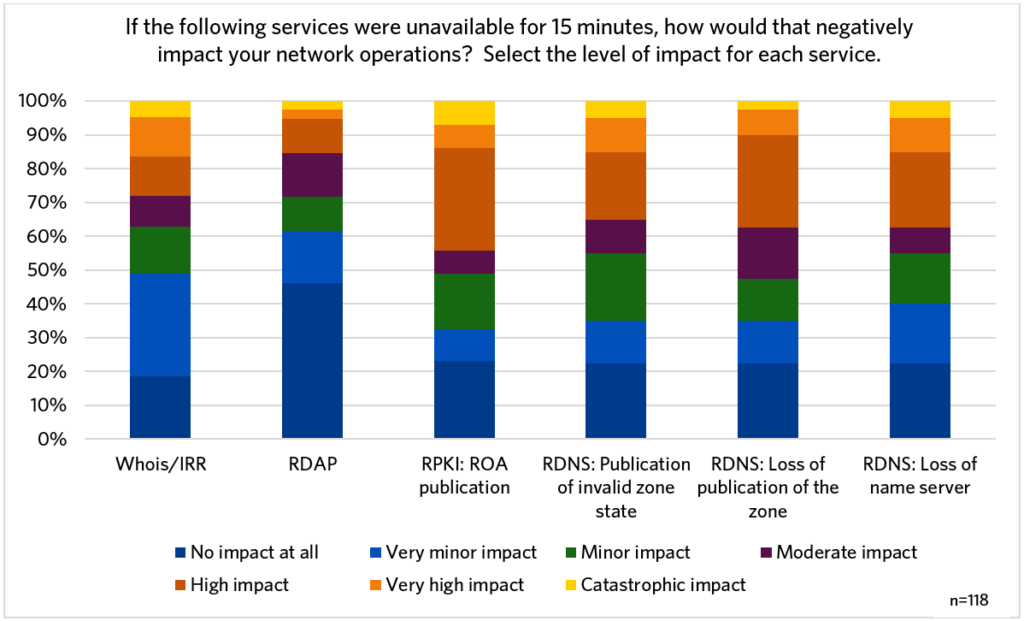
In June this year, a consultation process began with the community to help APNIC determine the scope, feasibility and appetite for improvements required to increase the availability of its critical services to a high level, beyond 99.99%.
The results of this process were shared with the APNIC Executive Council (EC) at their APNIC 56 meeting and briefly presented at the Products and Services session. The final report is now available, and here’s a summary of the findings.
Methodology
The community consultation comprised an online consultation form open to Members and the community (quantitative feedback) and interviews with selected Members and stakeholders (qualitative feedback).
Online consultation form
One hundred and eighteen respondents completed the form with an additional 91 partial completions. Respondents were drawn from 32 Asia Pacific economies and 16 industries; 84% were APNIC Members.
Interviews
Eleven organizations from nine economies were interviewed, covering service providers, a root operator, a Regional Internet Registry (RIR), National Internet Registries (NIRs), and a government agency (LEA).
While the online form aimed to capture the views of a broad spectrum of APNIC Members, the type of interviewee organizations were chosen as they operate at a larger scale or in a complex context with operational expertise (they were not intended to be representative of the entire membership or stakeholder base).
Key findings
- Overall, organizations appear satisfied with APNIC’s current best-effort availability.
- Almost three-quarters of online respondents (and nine of 11 organizations interviewed) agreed that their network operations were rarely disrupted by an APNIC service outage. Two interviewed organizations had experienced disruption in the past to RDNS services.

- If an outage were to occur, respondents believed the loss of RDNS services or ROA publication would be the most impactful.
- 37% of respondents said ROA publication unavailability would have a high impact or worse on their operations, while 21% said it would have no impact at all.
- For RDNS, 33% of respondents said publication of an invalid zone state for 15 minutes would have a high impact or worse on their operations, while 26% said it would have no impact at all.
- 36% said the loss of publication of the zone for 15 minutes would have a high impact or worse on their operations, while 24% said it would have no impact at all.
- 34% said loss of a name server for 15 minutes would have a high impact or worse on their operations, while 21% said it would have no impact at all.

- Over half of respondents’ organizations (55%) committed to 99.95% availability or less in their own service provision.
- Ten of the eleven organizations interviewed also operated at 99.95% or less for their services.
- Conversely, 16% of respondents’ organizations committed to 99.999% service availability. Only one of the interviewed organizations (a global cloud provider) operated some critical services at 99.999%.
- Most smaller Member organizations opposed increased fee investment in APNIC service availability, while larger Member organizations were more in favour.
- Overall, 40% of Members strongly oppose or oppose increased ongoing Member fee investment, with 31% of respondents supporting (or strongly supporting) an increased ongoing Member fee investment in critical service availability.
- 54% of organizations with 100 employees or less were against increased investment, while 29% of Member organizations with 101+ employees were opposed.
- 40% of larger organizations (101+ employees) were in support of further investment, while only 19% of smaller organizations were in favour.

- Accuracy of APNIC data is seen as more important than increased availability by the majority of respondents (64%).
After considering the results of the community consultation, the following recommendations were endorsed by the EC:
- APNIC will continue to use 99.99% as the availability target of critical services and 99.95% as the target of less critical services.
- Implement improved monitoring and measurement of availability, with the measurement methodology to be published.
- APNIC to pursue availability improvements including:
- Strengthening change management processes.
- Self-healing/recovery of application components with better automation.
- Improved 24×7 Tier-1 support.
I would like to thank everyone in the community who contributed their time and opinions to this process — your views were extremely valuable.
The views expressed by the authors of this blog are their own and do not necessarily reflect the views of APNIC. Please note a Code of Conduct applies to this blog.
